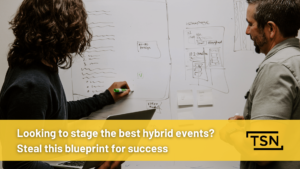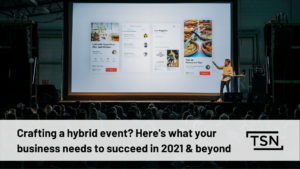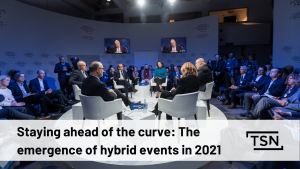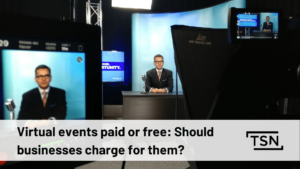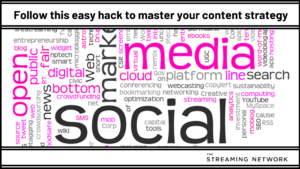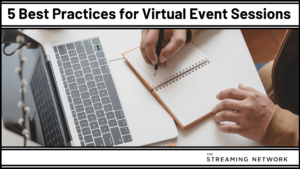Podcast: Play in new window | Download | Embed
Subscribe: Apple Podcasts | Google Podcasts | RSS
Lessons From The Frontline
2018 has been a great year for the team at The Streaming Network. We continued to test and discovered what’s effective (and what’s not). Our main takeaway this year was about getting the right message in front of the right people and at the right time.
Listen in on this week’s podcast as we focus on the most successful webinar strategies in 2018 for webinar marketers like yourself.
We will be tackling the following topics:
- The rise of Account-Based Marketing (ABM): Target your message to specific people, not general audiences.
- What’s an asymmetrical model?: Developing webinars meant for the future, not necessarily an upcoming event.
- Stop running webinars for the sake of running webinars: Repurpose valuable webinars to target certain customers.
- Hybrid events and why they’re effective.
The Complete Video Transcript
Peter Vamos: Welcome to LFTF, the show that no marketer interesting in webinars or inbound marketing can do without. With me, as usual, Matthew Ley. Matt, welcome.
Matt Ley: Thank you, Peter.
Peter Vamos: I’m Peter Vamos.
And here today we have–we don’t actually know what’s behind us. We have a green screen. What we’re seeing is a green screen. What you’re seeing is all kinds of stuff, I’m hoping a Christmas tree because it is that time of year.
Matt Ley: It’ll be Christmas trees, I’m sure, and a lot of other things that I will regret saying yes to this.
Peter Vamos: Yeah.
Matt Ley: You know, you had some fun with me last time with your fire burning and your–was it your beach house, I think?
Peter Vamos: We had a beach house view.
Matt Ley: Yeah.
Peter Vamos: Yeah.
Matt Ley: Yeah. So–.
Peter Vamos: –Yeah. So–and the idea here is, you know, we–we’re trying to have fun but we have a studio, and so why not have fun with it–?
Matt Ley: –Yeah–.
Peter Vamos: –And show the sorts of things that we can do?
This is our end of year episode. It’s our year in review, so we’re going to have a lot of fun. It’s our Christmas special.
Matt Ley: Yeah.
Peter Vamos: It’s our holiday special.
Matt Ley: Our holiday special.
Peter Vamos: It’s our holiday special.
Matt Ley: Our holiday, yeah.
Peter Vamos: There’s some eggnog in your cup. And we’re going to–.
Matt Ley: –There is–.
Peter Vamos: –Enjoy the final episode of the year.
So, what we’re going to talk about is the year that was, and then we’re also going to do a little bit of looking forward.
Matt Ley: Yeah.
Peter Vamos: So, let’s start with, you know, what are the big learnings from the world of webinars that marketers can take to the bank? What have you been thinking about? What–you know, what are the things that happened this year, the good, the bad, the ugly?
Matt Ley: Well, one of the things that I think was I guess refreshing or something that has come up is that, you know, since we started our thought leadership series with the Better Webinars program almost three years ago with Demand Metric, we’ve been talking about data. We’ve been talking about the stats, the benchmarks and how to improve upon them.
And just last night I was at the Legal Marketing Association conference and bumped into a couple of our customers and not customers. And we talked about what we did, and these marketers were regurgitating back to me all of their–all their data points, their conversion rates, their viewership numbers for live and for on-demand. And it was great to hear that coming back, to see that people are actually thinking about the webinar in that way, because it was always strange.
We’d go in and we could talk to people about, you know, their success of their email campaigns or their open rates or their click rates or their conversion rates. And then when it came to webinars, it was always this idea that, hey, we know they’re part of the story. We know they help, but we don’t have any straight lines between that and revenue. And since we’ve been working to help people with that, it was super refreshing just to encounter customers that were thinking about it on their own without our help.
We’ve got a few that, in our annual reviews, are bringing all of their datasets. They don’t have to do this. We’ll do it for you. But they’re pulling it all, bringing it to us, saying how do we improve this point, this point, or that point?
Peter Vamos: That’s amazing, because ultimately data is the big differentiator.
Matt Ley: Right.
Peter Vamos: I mean, you can talk to audiences. You can have your PowerPoint. But if–it’s what that brings to you when that webinar is done–.
Matt Ley: –Yeah–.
Peter Vamos: –What you can actually do to empower your sales team to drive business, those are the sorts of things that really make a difference.
Matt Ley: Yeah.
Peter Vamos: Just talking to people–.
Matt Ley: –Exactly–.
Peter Vamos: –Is not the endgame.
Matt Ley: No, I mean, it’s the right message in front of the right person at the right time.
Peter Vamos: Yeah.
Matt Ley: And so, that’s the other thing that I found very interesting, is that, you know, about a year or so ago, I don’t know when it was, so it was the–when Microsoft moved to the platform.
And a year later, we were at Webinar World, and we had that great stat where we showed them going from, like, 200 a year to 200 a month or whatever the number was in webinars. And we talked about how they were utilizing the simulated live model, and they were trying to get their past webinars on the right topic in front of the right people.
Well, this year has been the rise of ABM.
Peter Vamos: Um-hmm.
Matt Ley: It went from a word that we heard a lot–excuse me–to a word that is on the tips of every marketer’s mouth. And personalization is what, you know, people are talking to us every day about, about their strategies around that.
And so, clearly large organizations like Microsoft are usually ahead of the game when it comes to these things. But now we’re seeing organizations of all sizes, really, employing this methodology of the right time and working on their webinars in a–I call it an asymmetrical model.
You develop a webinar ’cause it’s really great content, you deliver it at a certain time and then you keep it in your back pocket, and you rerun it and get it–or get it out through your campaigns to the right people in the pipeline, in the funnel as they come–.
Peter Vamos: –Right–.
Matt Ley: –Through. And–.
Peter Vamos: –So, it’s–account-based marketing is what you’re talking. It’s–ABM is the ability to target different executives within an organization, so all the executives within any group of organizations that you’re actually thinking is your right customer base.
Matt Ley: There’s a–I think there’s a lot of aspects of account-based marketing, and I think what we’ve seen from the webinar side is more this idea that they know that the person who’s evaluating a platform, product, or service, the team of evaluators, they will sit and spend 40 minutes, right, and watch a webinar. And the key is is getting the right content in front of them at the right time.
And so, rather than every single month running top of funnel, middle funnel, bottom funnel webinars, new ones, rerunning them, coming up with new ideas, is they’re finding those really great webinars and then they’re rerunning them and, in some cases, depending on the platforms they have in place, repackaging them for specific customers. That’s the account-based side.
But I think the key here is that after–excuse me–after years of talking about, you know, integrations and how automation and integration is so important, we move to this idea that’s going back to personalization. But you can’t really effectively personalize if you haven’t done that work on the integration side, because you don’t know who those people are. You don’t have that data in place.
And so, since so many of our customers–I mean, close to 80% of our webinar customers are–marketers are integrated with their marketing automation and their CRM, as they’ve started to move into this idea of ABM or personalization, it’s easy for them to adopt this methodology.
Peter Vamos: Right.
Matt Ley: And so, it’s taken some time for it to get there, but it is interesting to see. And what is means is that, in our surveys again–we survey prospects and customers going into engagements, whether it be a sales engagement or a–like a renewal engagement, and we ask what’s your plan for events next year. Like, you know, how many webinars do you expect to hold, increase/decrease? And everyone’s increasing.
Peter Vamos: Right.
Matt Ley: Everyone’s increasing their webinar–they’re delivering more webinars. Maybe not more net new content webinars, maybe not more true live webinars, but definitely more in general.
Peter Vamos: Okay, great.
We’ll try to pull some stats as well that we can maybe throw on our screen. But do you have any stats that you can sort of pull up, the–?
Matt Ley: –Growth numbers?
Peter Vamos: Yeah.
Matt Ley: So, hopefully it’s ready by the time this launches, and I’m not going to make any promises. But we have been working on the Canadian benchmarks report that basically supplements the benchmark study. We’re always a part of that study, but there’s no breakout for Canada as a region, so we generally do that ourselves within our own customer base.
And we’ve always focused on the big stats, like when to hold a webinar and the registration to viewership conversion in on-demand in all that stuff. And we’re generally pretty much aligned with the U.S., no big surprises there, probably because, in a global economy, many Canadian B2B firms sell to the U.S., right?
Peter Vamos: Right.
Matt Ley: So, it’s not a big shock. But one of the things that we did not focus on was that volume number.
And so, this year we added that in. And we’ve always been, you know, quite far behind the U.S. actually. It just wasn’t a stat that we actually looked at. So, now that we’re focusing on volume and adding that in, what we’re seeing is that Canada is catching up.
So, you said mature industry. Yes, webinars have been around for a very long time. Heck, this is our 10th year in business ourselves. But what we’re seeing now is this increase in just the number of events.
Peter Vamos: Right.
Matt Ley: And those who have not embraced the reusing of webinar content, when I bring up these numbers, they’re–they think it’s magic. Like, how the heck do people do that? Are they just webinaring all the time?
So, it takes some time on our platform generally, or on a platform like ours, before people start to get this and be able to utilize it. But it is happening, and it’s happening on–in a big way.
Peter Vamos: Right. Excellent. Okay.
In terms of surprises, what was the big surprise for you coming out of 2018? What happened this year that you didn’t expect, and/or are either happily surprised about or perhaps not? What’s this–what’s the thing?
Matt Ley: Well, our biggest–our overall biggest growth sector this year was something that–I mean, I knew it. I knew it because midway through the year we had to hire a bunch of people to support it. But it was exciting when we were going through the numbers in the pipeline in December to look at events, hybrid events and the whole idea of the webcast.
Peter Vamos: Right.
Matt Ley: So, the studio has been busier than it has been for–in a long time with webcast events, not just production for social or whatever it is. And the team is on-site more times this year than they have in–ever.
Peter Vamos: Right.
Matt Ley: And so, this idea that I think there are some industries that are further behind than others–we will not name any names–and in-person events were a huge part of their marketing strategy. And they begrudgingly started introducing virtual because they had to, and now we’re seeing a real focus on it.
Peter Vamos: And what happened in–like, this year? What was the thing that changed that?
Matt Ley: I don’t think anything changed. There was no tipping point, right? And some of the datasets on this are anecdotal.
Peter Vamos: Um-hmm.
Matt Ley: I mean, we do more events than anybody in this country and we support more customers than anybody, but sometimes it’s customer mix. But I really think it’s one of those things that people just–it took a while for some people to just embrace it–.
Peter Vamos: –Right–.
Matt Ley: –Right? And so, you know, it got to the point where maybe last year’s program of in-person events–or their conference or whatever it is got to the point where it just performed so poorly that it was time–.
Peter Vamos: –Right–.
Matt Ley: –To really invest, right?
And what’s fun for me is I was involved in some events this year where people were moving from the focus on the physical to the focus on the virtual, which meant more budget, which we love, but also more exciting premises, shows, and ideas that they’re–that you can see that they’re really focusing on this part of it, when it was generally an afterthought.
Peter Vamos: Right.
Matt Ley: So, it is growing. And it’s growing because clearly, you know, the audience numbers are–have always been higher. And I think with the data and the analytics that we’ve been talking about from a webinar perspective for the past two, three years, now they’re recognizing that in some cases they can get better information if it’s online versus if it’s in person.
Peter Vamos: Right.
Matt Ley: So, let’s think about, you know, when you hold an event or when we hold an event that’s got an in-person element. Who shows up? Our fans, our customers who always use our services, people who are locked into contracts. They’re very important. We want them. We actually want them in person too, because they’re our advocates. We want to shake their hands and we want to thank them.
Peter Vamos: Yeah.
Matt Ley: But from a prospect conversion standpoint and when a prospect comes to a physical event that we have, they’re going to stay in the background. They’re going to look to learn. But we don’t know what their feedback was. We can try and anecdotally get that. Hopefully we talked with them. But on a virtual, we know–.
Peter Vamos: –Yeah–.
Matt Ley: –Right?
So, the last virtual conference I was a part of was with a company that really, really invested well in making sure the virtual audience was taken care of. I was part of, like, 60 presentations, not a huge audience. I think I had 27 live viewers and I’ve had about 40 on-demand. But of those 27 live viewers, we booked 21 meetings.
Peter Vamos: Right.
Matt Ley: They were there. I knew that those people, those 21, were–all watched my entire presentation, downloaded stuff. So, the data there was better than the data from the folks in the room who I shook hands with–.
Peter Vamos: –Right–.
Matt Ley: –At the conference.
So, I think that it’s been just, you know, a long time coming. This is the way they’re going–businesses are going to have to operate to reach the number of people they need to reach. And there’s probably more trust in it, right?
Now, again–.
Peter Vamos: –It’s probably also–sorry to interrupt you.
Matt Ley: Go ahead. No.
Peter Vamos: But it’s probably also that people are busy. People are getting busier and busier and busier, the–because of the changes in bandwidth, the ability to deliver, like, high quality product in an on-demand or a virtual live environment. Those–like, I know the numbers in a lot of events are declining.
Matt Ley: Yeah.
Peter Vamos: Right. This is definitely–so, people are starting to see, like, how are we going to offset that, right? And we’re also selling it, right? We’re out there pitching this sort of stuff.
Matt Ley: Yeah.
Peter Vamos: So–.
Matt Ley: –And I always–you know, have to always give this caveat. Like, you know, we do–you know, thousands of events will be part of the data, assuming it’s on the website.
Peter Vamos: Yeah.
Matt Ley: But they’re our customers, right?
Peter Vamos: Yeah.
Matt Ley: So, our customers have a unique advantage of that when they do a physical event like this. They’re running the same platform that they’re doing their webinars on, so they’ve got that tie in to CRM. They’ve got that integration already done.
They’ve got the–they know how to take data and turn it into dollars already. So, when they make this move, it’s easier for them, whereas if you’re not doing that and you’ve got one product that does X, one product that does Y, it’s harder to sort of, you know, pull that data and analyze it–.
Peter Vamos: –Yeah–.
Matt Ley: –Right?
Peter Vamos: Yeah.
Matt Ley: Like I always say, you can do it on any product, it’s just easier on ours just because of the way it’s built.
So, I think our customers, as much or more than anyone, are starting to say, yes, we need to get this in front of this event, or this–you know, and this webinar or this webcast platform in front of whatever’s happening here–.
Peter Vamos: –Right–.
Matt Ley: –So that we can analyze this other data.
Peter Vamos: Right.
So, we did a two-part podcast on hybrids. And hopefully somewhere here there is a URL that can take you there and you can watch it, ’cause we dug really deeply into it and it was a really good podcast.
Matt Ley: Yeah.
Peter Vamos: But definitely I agree with you. I think that was a really interesting thing that happened in 2018.
In terms of–and maybe you just answered this. If you did, just say we just answered this. But in terms of the most significant thing that you came to understand this year about your business at The Streaming Network–.
Matt Ley: –Yeah–.
Peter Vamos: –Is there a thing that you–was there a-ha moment this year that–about your business?
Matt Ley: That is a–that–you know, it’s interesting. We spent a long time–not a long time, but we spent a couple years making the transition from an event company to a subscription-based software company. It’s the way of the world. And it was the direction was taking and we needed to follow suit. And it was a big change.
And as we made that change and we started to reshape the organization, we were, I think in some cases, trying to push customers into our slots, right? We might have had two or three. And then back in the day before that, we had almost zero slots. What is it that you want to do? We’ll help you do it. We’ll match budget with project and that sort of thing.
And this year what I think we’ve effectively done is we’ve gone back to our roots a little bit, but we’ve merged the two together. So, when you’re analyzing any one customer that we have, like a top customer, the product mix is drastically different.
The professional–we have customers who are spending, like, $5,000 on platform and $80,000 on production services. Clearly we’ve got the ones that go the other way too. And, you know, the–remembering that, you know, we’ve been at this for 10 years, we know this industry better than any of our customers or anybody that we’re dealing with, and we can help them in many ways around this product set.
And so, I think in going back to that methodology, it’s seen our–it’s seen expansion within our accounts. The value we’re bringing to our customers I think is different. We’re not just another invoice they get once a year and a–you know, a CSM team they can call. There’s a lot more human engagement that’s going on from our side.
And so, it was an a-ha moment. It was–it helped–it’s helping me now ’cause we’re in the middle of it. We just got back from our strategy summit. I mean, it’s helping me now and us frame what we’re going to do with the business next year and how we’re going to–and what we’re going to add and how we’re going to, you know, further enable our customers.
Peter Vamos: Right. Right.
So, we covered a lot. I think this has been really interesting. What we’re going to do is we’re going to have a part two of this. We’ll close this up and start up, but some really, really great insights so far in our year in review.
And coming back, we’ll talk a little bit more about the year that was, but we’re also going to start to dig into a little bit about what is coming in 2019, what we think are going to be the important things you need to be thinking about. So, until then, Matthew, thank you very much.
Matt Ley: Peter, thank you.
Peter Vamos: And we’ll see you again.

